438. European Bee-eater Merops apiaster (Europese byvreter)
Order: Coraciiformes. Family: Meropidae
Description
Length 27-29 cm, including the two long central tail feathers. This species, like other bee-eaters, is a richly-coloured, slim bird. The head is turquoise-blue, chestnut and the bill is coloured grey-black. The eyes are red. The forehead is white, the throat is yellow bordered by black, and the underparts are blue. Brown and yellow upperparts, green wings.
In breeding plumage, it has a rich chestnut crown that blends into gold on its back. Sexes similar. Male European bee-eaters have a chestnut-coloured patch in the middle of the wing, in females this patch is usually smaller or even absent. Occasionally, females may also be distinguished from the males by having a green back.
The wings and backs of juvenile European bee-eaters are entirely green, and the eyes are brown, in contrast to the bright red eyes of adults.
Distribution
Common and widespread, with a worldwide population of 4 million, occurring in Europe, south-west Asia and sub-Saharan Africa.
Fairly common summer visitor to Europe and western Asia. Breeds over much of Iberia, in southern France and parts of Italy, and from the eastern Adriatic to the Black and Caspian Seas. In Russia breeds north to about 57°N. Found throughout Turkey and the Caucasus, in northern Iraq and in scattered parts of the Middle East. In the Mediterranean breeds on the Balearics, Corsica and Sardinia, Crete and Cyprus. In North Africa breeds widely across the north-west. Further east breeds over much of Iraq and Iran and discontinuously east to western China. In southern Africa it is a non-breeding visitor to Namibia, Botswana, Zimbabwe, Mozambique and north-eastern and central South Africa. Also breeds in parts of southern Africa and has a breeding population in the Western and Eastern Cape.
Movements and migrations
Its movements are complex, with breeding and non-breeding populations in southern Africa.
One population breeds in various areas of Eurasia and northern Africa, moving to down to south-central and southern Africa in October in the non-breeding season, leaving again in March. This population occurs in Namibia, Mozambique, Zimbabwe, Botswana and the northern parts of southern Africa.
The southern African breeding population arrives from their non-breeding grounds in central Africa in September. They mainly breed in the Western and Eastern Cape, leaving southern Africa in the period from January-February.
Habitat
It generally prefers temperate habitats, especially in the fynbos biome, avoiding excessively arid or wet areas.
Diet
Feeds exclusively on insects, eating mainly bees, wasps, flying ants and termites. It mainly hunts aerially, acrobatically hawking insects and sometimes ascending to 150 m above ground! It also catches insects from a perch.
Breeding
During the courtship and laying periods, the male fulfils part of the female’s food requirements by bringing her prey. Monogamous colonial nester, nesting in groups of 10-30, sometimes 100 pairs. It often nests with other bird species, such as Banded martin, Brown-throated martin and Pied starling. Breeding pairs are assisted by non-breeding individuals and sometimes juveniles. Both sexes excavate the nest, which is a 0.7-2.0 m long tunnel ending in a chamber about 25 cm wide. It is dug into riverbanks, gullies, or quarries with dry clay. Egg-laying season is usually from October-May. It lays 2-6 eggs, which are incubated for 19-28 days. The chicks stay in the nest for about 30-31 days, after which they may come back to the nest to roost. After the young have fledged, the parents continue to feed them for a considerable time, as catching insects on the wing is a skill that takes time to learn.
Call
Various liquid and melodious trill notes prruip, pruik or kruup. Listen to Bird Call.
Status
Common summer visitor.
Africa Wild Bird Book
European Bee-eater Photos
438. European Bee-eater Merops apiaster
 © Bushcraft
© Bushcraft
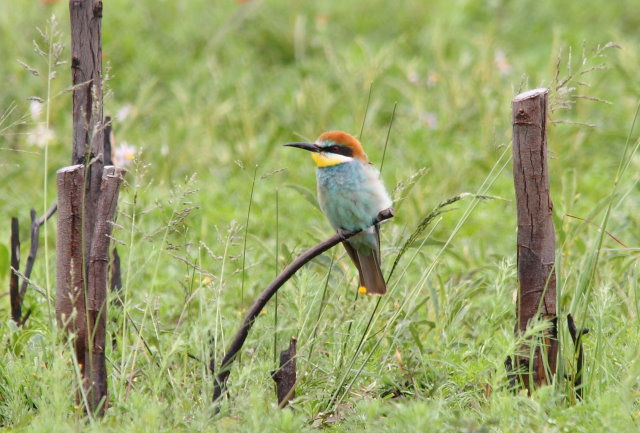 © Flutterby
© Flutterby
 © JustN@ture
© JustN@ture
 © leachy
© leachy
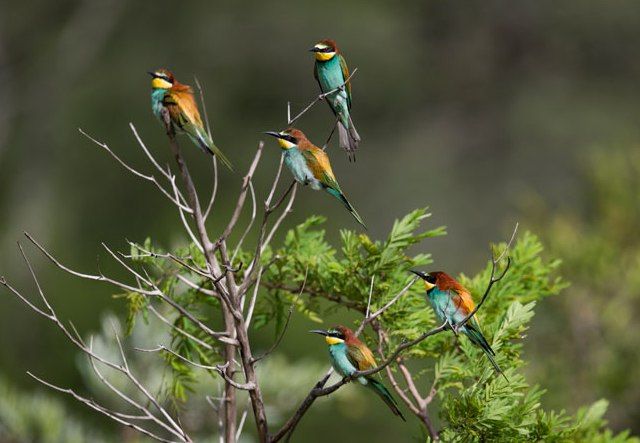 © Pumbaa
© Pumbaa
Links:
Species text Sabap1
Sabap2
Hockey, P.A.R. 1996. Africa’s bee-eaters: a guide to their identification. Africa - Birds & Birding 1(3):59-63.]
 © Bushcraft
© Bushcraft © Flutterby
© Flutterby © JustN@ture
© JustN@ture © leachy
© leachy © Pumbaa
© PumbaaLinks:
Species text Sabap1
Sabap2
Hockey, P.A.R. 1996. Africa’s bee-eaters: a guide to their identification. Africa - Birds & Birding 1(3):59-63.]
Southern Carmine Bee-eater
441. Southern Carmine Bee-eater Merops nubicoides (Rooiborsbyvreter)
Order: Coraciiformes. Family: Meropidae
Description
The largest of the southern African Bee-eaters, with a length of approximately 25 cm excluding the 12 cm tail streamers, and a weight around 62 g. The plumage is pinkish-red ('carmine'), the upperparts darker than the lower. The forehead and crown are bright blue; the lores and ear coverts are black. The lower back and rump are light blue; the slender, decurved bill is black and the eyes are dark red-brown. It has grey legs. Both sexes are similar and the female has shorter streamers. The juvenile lacks the elongated central rectrices and is duller. It has pale pink (or rarely pale blue) chin and throat. The mask is dull black.
Distribution
Endemic to sub-Saharan Africa, occurring from Tanzania south to north-eastern Namibia (including the Caprivi Strip), northern and eastern Botswana, Zimbabwe, Mozambique and north-eastern South Africa.

Habitat
Savanna, swamps with scattered dead trees and cultivated land, especially in areas surrounding rivers and lakes.
Movements and migrations
Southern carmine bee-eaters are intra-African migrants and arrive at their breeding grounds during August or September. The birds have a fairly complex migration pattern and do not remain at their breeding sites for more than a few months. Around November they will move south for a few months before heading northwards into Kenya, the Democratic Republic of Congo and surrounding areas of equatorial Africa until the next breeding season arrives.
Diet
It feeds exclusively on insects, which are generally larger than the prey of other bee-eaters. Does most of its foraging aerially.
Breeding
It is monogamous, living and breeding in huge colonies of 100 to 1000 nests. It may rarely change the colony site, sometimes moving 7 km in the process. The nest is excavated by both sexes, consisting of a 1-3.5 m long tunnel ending in an unlined nest chamber. It is usually dug into sandy riverbanks, ditches or sloping ground. Egg-laying season is year-round, peaking from September-October. It lays 1-6 white eggs, which are incubated by both sexes, for 11-13 days. The chicks stay in the nest for 11-20 days, and are brooded continuously by both parents for the whole nestling period.
Call
Their call is a loud gro-gro-gro. Listen to Bird call.
Status
Common summer visitor.
Order: Coraciiformes. Family: Meropidae
Description
The largest of the southern African Bee-eaters, with a length of approximately 25 cm excluding the 12 cm tail streamers, and a weight around 62 g. The plumage is pinkish-red ('carmine'), the upperparts darker than the lower. The forehead and crown are bright blue; the lores and ear coverts are black. The lower back and rump are light blue; the slender, decurved bill is black and the eyes are dark red-brown. It has grey legs. Both sexes are similar and the female has shorter streamers. The juvenile lacks the elongated central rectrices and is duller. It has pale pink (or rarely pale blue) chin and throat. The mask is dull black.
Distribution
Endemic to sub-Saharan Africa, occurring from Tanzania south to north-eastern Namibia (including the Caprivi Strip), northern and eastern Botswana, Zimbabwe, Mozambique and north-eastern South Africa.

Habitat
Savanna, swamps with scattered dead trees and cultivated land, especially in areas surrounding rivers and lakes.
Movements and migrations
Southern carmine bee-eaters are intra-African migrants and arrive at their breeding grounds during August or September. The birds have a fairly complex migration pattern and do not remain at their breeding sites for more than a few months. Around November they will move south for a few months before heading northwards into Kenya, the Democratic Republic of Congo and surrounding areas of equatorial Africa until the next breeding season arrives.
Diet
It feeds exclusively on insects, which are generally larger than the prey of other bee-eaters. Does most of its foraging aerially.
Breeding
It is monogamous, living and breeding in huge colonies of 100 to 1000 nests. It may rarely change the colony site, sometimes moving 7 km in the process. The nest is excavated by both sexes, consisting of a 1-3.5 m long tunnel ending in an unlined nest chamber. It is usually dug into sandy riverbanks, ditches or sloping ground. Egg-laying season is year-round, peaking from September-October. It lays 1-6 white eggs, which are incubated by both sexes, for 11-13 days. The chicks stay in the nest for 11-20 days, and are brooded continuously by both parents for the whole nestling period.
Call
Their call is a loud gro-gro-gro. Listen to Bird call.
Status
Common summer visitor.
Southern Carmine Bee-eater Photos
441. Southern Carmine Bee-eater Merops nubicoides (Rooiborsbyvreter)
Order: Coraciiformes. Family: Meropidae
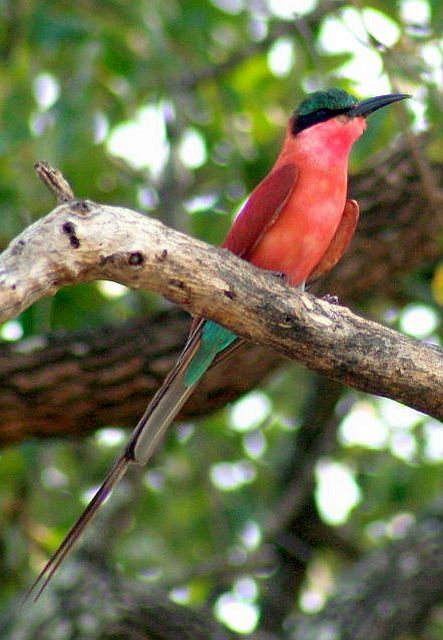 © Flutterby
© Flutterby
 © Super Mongoose
© Super Mongoose
Kruger National Park, Tihongonyeni
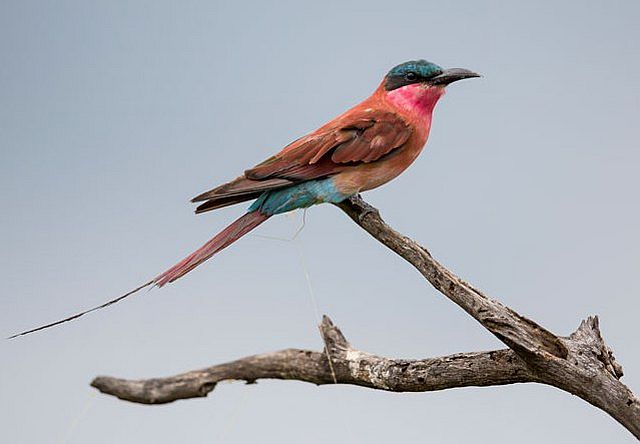 © Pumbaa
© Pumbaa
 © Flutterby
© Flutterby
 © leachy
© leachy
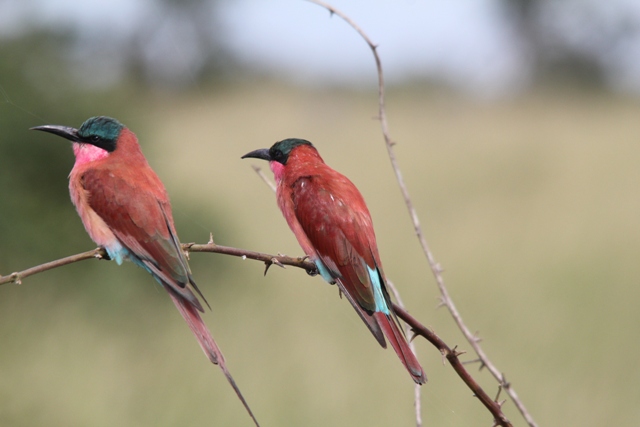 © pooky
© pooky
 © leachy
© leachy
Immature
 © Sprocky
© Sprocky
immature
Links:
Species text Sabap1
Sabap2: http://sabap2.adu.org.za/species_info.p ... #menu_left
Van Rooyen, C., Froneman, A. & Ryan, P.G. 2009. Showtime: Carmine Bee-eaters. Africa - Birds & Birding 14(4):39-45.
Hockey, P.A.R. 1996. Africa’s bee-eaters: a guide to their identification. Africa - Birds & Birding 1(3):59-63.
Order: Coraciiformes. Family: Meropidae
 © Flutterby
© Flutterby © Super Mongoose
© Super MongooseKruger National Park, Tihongonyeni
 © Pumbaa
© Pumbaa  © Flutterby
© Flutterby © leachy
© leachy © pooky
© pooky © leachy
© leachyImmature
 © Sprocky
© Sprockyimmature
Links:
Species text Sabap1
Sabap2: http://sabap2.adu.org.za/species_info.p ... #menu_left
Van Rooyen, C., Froneman, A. & Ryan, P.G. 2009. Showtime: Carmine Bee-eaters. Africa - Birds & Birding 14(4):39-45.
Hockey, P.A.R. 1996. Africa’s bee-eaters: a guide to their identification. Africa - Birds & Birding 1(3):59-63.
ORDER BUCEROTIFORMES
Bucerotiformes share many characteristics with Coraciiformes from which they are now separated. As originally defined, the Coraciiforme order did not respect monophyly (i.e., property of a clade comprising all descendants of a common ancestor and only these), since phylogenomic analysis showed that Piciformes were included in it. Monophyly was restored by recognizing Bucerotiformes, Piciformes and the remaining Coraciiformes as separate orders.
ORDER BUCEROTIFORMES
Family Upupidae (Hoopoe)
Family Phoeniculidae (Wood Hoopoes)
Family Bucerotidae (Hornbills)
Family Bucorvidae (Ground Hornbills)
ORDER BUCEROTIFORMES
Family Upupidae (Hoopoe)
Family Phoeniculidae (Wood Hoopoes)
Family Bucerotidae (Hornbills)
Family Bucorvidae (Ground Hornbills)
Family Upupidae (Hoopoe)
The number of hoopoe species is under some debate, with disagreement on whether one, two, three or four species currently exist. The European hoopoe is widely accepted, but there is some consideration about splitting the species into both European and African variations. The Madagascar hoopoe is more widely acknowledged as a separate species, though it is not universally accepted. The giant hoopoe was also in the Upupidae family, but is now extinct.
Regardless of how many distinct hoopoe species are recognized, they are all insectivorous birds that prefer relatively dry, open habitats and thrive near human habitation. Their plumages and songs are similar but have some regional variations that are the general reasoning for splitting the species.
While there may not be many birds in the Upupidae family, these birds are related to kingfishers, rollers and hornbills.
Hoopoes are medium sized birds, 25–32 cm long, with a 44–48 cm wingspan. They are highly distinctive, with a long, thin tapering bill that is black with a fawn base. The strengthened musculature of the head allows the bill to be opened when probing inside the soil. They have broad and rounded wings capable of strong flight; these are larger in the northern migratory species. The Hoopoe has a characteristic undulating flight, which is like that of a giant butterfly, caused by the wings half closing at the end of each beat or short sequence of beats.
The call is typically a trisyllabic oop-oop-oop, which gives rise to its English and scientific names, although two and four syllables are also common.
Hoopoes are widespread in Europe, Asia, and North Africa, Sub-Saharan Africa and Madagascar. Most European and north Asian birds migrate to the tropics in winter. In contrast the African populations are sedentary year-round.
Hoopoes need bare or lightly vegetated ground on which to forage and vertical surfaces with cavities (such as trees, cliffs or even walls, nestboxes, haystacks, and abandoned burrows in which to nest. These requirements can be provided in a wide range of ecosystems and as a consequence they inhabit a wide range of habitats from heathland, wooded steppes, savannas and grasslands, as well as glades inside forests.
The diet is mostly composed of insects, although small reptiles, frogs and plant matter such as seeds and berries are sometimes taken as well. They are solitary foragers and feed on the ground. More rarely they will feed in the air, in pursuit of numerous swarming insects, where their strong and rounded wings make them fast and manoeuvrable. More commonly their foraging style is to stride on relatively open ground and periodically pause to probe the ground with the full length of their bill. Insect larvae, pupae and mole crickets are detected by the bill and either extracted or dug out with the strong feet. In addition to feeding in soil Hoopoes will feed on insects on the surface, as well as probing into piles of leaves and even using the bill to lever large stones and flake off bark. Common diet items include crickets, locusts, beetles, earwigs, cicadas, ant lions, bugs and ants. These can range from 10 to 150 mm in length, with the preferred size of prey being around 20–30 mm. Larger prey items are beaten against the ground or a preferred stone in order to kill them and remove indigestible body parts such as wings and legs.
Hoopoes are monogamous, although the pair bond apparently only lasts for a single season. They are also territorial, with the male calling frequently to advertise his ownership of the territory. The nest is in a hole in a tree or wall, with a narrow entranc. The female alone is responsible for incubating the eggs. clutch size varies with location, with northern hemisphere birds laying more eggs than those in the southern hemisphere and birds in higher latitudes having larger clutches than those closer to the equator.
The Hoopoes have well-developed anti-predator defences in the nest. The uropygial gland of the incubating and brooding female is quickly modified to produce a foul-smelling liquid, and the glands of nestlings do so as well. These secretions are rubbed into the plumage. The secretion, which smells like rotting meat, is thought to help deter predators, as well as deter parasites and possibly act as an antibacterial agent. The secretions stop soon before the young leave the nest. In addition to this secretion nestlings are able to direct streams of faeces at nest intruders from the age of six days, and will also hiss at intruders in a snake like fashion.
The incubation period for the species is between 15 and 18 days. During incubation the female is fed by the male. The incubation period begins as soon as the first egg is laid, so the chicks are born asynchronously. The chicks are brooded by the female for between 9 to 14 days. The female later joins the male in the task of bringing food.
Family Upupidae (Hoopoe)
Upupa africana African Hoopoe 451
Regardless of how many distinct hoopoe species are recognized, they are all insectivorous birds that prefer relatively dry, open habitats and thrive near human habitation. Their plumages and songs are similar but have some regional variations that are the general reasoning for splitting the species.
While there may not be many birds in the Upupidae family, these birds are related to kingfishers, rollers and hornbills.
Hoopoes are medium sized birds, 25–32 cm long, with a 44–48 cm wingspan. They are highly distinctive, with a long, thin tapering bill that is black with a fawn base. The strengthened musculature of the head allows the bill to be opened when probing inside the soil. They have broad and rounded wings capable of strong flight; these are larger in the northern migratory species. The Hoopoe has a characteristic undulating flight, which is like that of a giant butterfly, caused by the wings half closing at the end of each beat or short sequence of beats.
The call is typically a trisyllabic oop-oop-oop, which gives rise to its English and scientific names, although two and four syllables are also common.
Hoopoes are widespread in Europe, Asia, and North Africa, Sub-Saharan Africa and Madagascar. Most European and north Asian birds migrate to the tropics in winter. In contrast the African populations are sedentary year-round.
Hoopoes need bare or lightly vegetated ground on which to forage and vertical surfaces with cavities (such as trees, cliffs or even walls, nestboxes, haystacks, and abandoned burrows in which to nest. These requirements can be provided in a wide range of ecosystems and as a consequence they inhabit a wide range of habitats from heathland, wooded steppes, savannas and grasslands, as well as glades inside forests.
The diet is mostly composed of insects, although small reptiles, frogs and plant matter such as seeds and berries are sometimes taken as well. They are solitary foragers and feed on the ground. More rarely they will feed in the air, in pursuit of numerous swarming insects, where their strong and rounded wings make them fast and manoeuvrable. More commonly their foraging style is to stride on relatively open ground and periodically pause to probe the ground with the full length of their bill. Insect larvae, pupae and mole crickets are detected by the bill and either extracted or dug out with the strong feet. In addition to feeding in soil Hoopoes will feed on insects on the surface, as well as probing into piles of leaves and even using the bill to lever large stones and flake off bark. Common diet items include crickets, locusts, beetles, earwigs, cicadas, ant lions, bugs and ants. These can range from 10 to 150 mm in length, with the preferred size of prey being around 20–30 mm. Larger prey items are beaten against the ground or a preferred stone in order to kill them and remove indigestible body parts such as wings and legs.
Hoopoes are monogamous, although the pair bond apparently only lasts for a single season. They are also territorial, with the male calling frequently to advertise his ownership of the territory. The nest is in a hole in a tree or wall, with a narrow entranc. The female alone is responsible for incubating the eggs. clutch size varies with location, with northern hemisphere birds laying more eggs than those in the southern hemisphere and birds in higher latitudes having larger clutches than those closer to the equator.
The Hoopoes have well-developed anti-predator defences in the nest. The uropygial gland of the incubating and brooding female is quickly modified to produce a foul-smelling liquid, and the glands of nestlings do so as well. These secretions are rubbed into the plumage. The secretion, which smells like rotting meat, is thought to help deter predators, as well as deter parasites and possibly act as an antibacterial agent. The secretions stop soon before the young leave the nest. In addition to this secretion nestlings are able to direct streams of faeces at nest intruders from the age of six days, and will also hiss at intruders in a snake like fashion.
The incubation period for the species is between 15 and 18 days. During incubation the female is fed by the male. The incubation period begins as soon as the first egg is laid, so the chicks are born asynchronously. The chicks are brooded by the female for between 9 to 14 days. The female later joins the male in the task of bringing food.
Family Upupidae (Hoopoe)
Upupa africana African Hoopoe 451
- Flutterby
- Posts: 44029
- Joined: Sat May 19, 2012 12:28 pm
- Country: South Africa
- Location: Gauteng, South Africa
- Contact:
African Hoopoe
451. African Hoopoe Upupa africana (Afrikaanse Hoephoep)
Order: Bucerotiformes. Family: Upupidae
Description
Unmistakable with a long, decurved bill, and long, black-tipped crest which is erect when bird is alarmed.
Female is duller rufous than male and slightly greyer on face and breast.
Juvenile like female but duller and with shorter crest. Bill initially shorter and less decurved.
Distribution
It occurs almost everywhere in southern Africa except for deserts, arid karoo and Lesotho.
Habitat
It generally prefers open woodland with short grass undergrowth, and it has adapted well to the introduction of man-made habitats, such as parks, gardens, orchards and plantations.
Diet
Feeds throughout the day, usually in low grass or bare soil. It probes the ground with its slightly open bill, trying to find insects. Once the prey is caught, it will sometimes beat the prey on the ground in order to reduce it to bite-size pieces. The diet includes insects and their larvae, earthworms, small frogs, snakes, lizards, and termites, which may be taken in flight.
Breeding
Monogamous and occasionally breeding co-operatively. It mainly nests in tree holes, either natural or made by barbets or woodpeckers. It can also nest in a termite mound, stone wall, ground hole, drainage pipe, crevice in masonry, underfloor space, house ceiling or nest box. The nest is always chosen by the male, who defends it vigorously. Egg-laying season is from August-February, peaking at September-November. It lays 4-7 eggs, usually in successive days, although it sometimes takes a two day break between the first and second egg. Incubation starts when the last egg has been laid, and is done solely by the female for 15-16 days. The female will huff and hiss if disturbed on nest. The male does all the hunting for the chicks in the first 7-8 days of their lives, after which the female joins in as well. The chicks stay in the nest for 26-32 days, after which they leave the nest for the surrounding foliage, becoming fully independent about a month later.
Parasitised by Greater Honeyguide.
Call
Soft, low and sustained hoo-poo or hoo-poo-poo. Listen to Bird Call
Status
Fairly common, with resident, nomadic and migratory populations. Usually in pairs.
Order: Bucerotiformes. Family: Upupidae
Description
Unmistakable with a long, decurved bill, and long, black-tipped crest which is erect when bird is alarmed.
Female is duller rufous than male and slightly greyer on face and breast.
Juvenile like female but duller and with shorter crest. Bill initially shorter and less decurved.
Distribution
It occurs almost everywhere in southern Africa except for deserts, arid karoo and Lesotho.
Habitat
It generally prefers open woodland with short grass undergrowth, and it has adapted well to the introduction of man-made habitats, such as parks, gardens, orchards and plantations.
Diet
Feeds throughout the day, usually in low grass or bare soil. It probes the ground with its slightly open bill, trying to find insects. Once the prey is caught, it will sometimes beat the prey on the ground in order to reduce it to bite-size pieces. The diet includes insects and their larvae, earthworms, small frogs, snakes, lizards, and termites, which may be taken in flight.
Breeding
Monogamous and occasionally breeding co-operatively. It mainly nests in tree holes, either natural or made by barbets or woodpeckers. It can also nest in a termite mound, stone wall, ground hole, drainage pipe, crevice in masonry, underfloor space, house ceiling or nest box. The nest is always chosen by the male, who defends it vigorously. Egg-laying season is from August-February, peaking at September-November. It lays 4-7 eggs, usually in successive days, although it sometimes takes a two day break between the first and second egg. Incubation starts when the last egg has been laid, and is done solely by the female for 15-16 days. The female will huff and hiss if disturbed on nest. The male does all the hunting for the chicks in the first 7-8 days of their lives, after which the female joins in as well. The chicks stay in the nest for 26-32 days, after which they leave the nest for the surrounding foliage, becoming fully independent about a month later.
Parasitised by Greater Honeyguide.
Call
Soft, low and sustained hoo-poo or hoo-poo-poo. Listen to Bird Call
Status
Fairly common, with resident, nomadic and migratory populations. Usually in pairs.
- Flutterby
- Posts: 44029
- Joined: Sat May 19, 2012 12:28 pm
- Country: South Africa
- Location: Gauteng, South Africa
- Contact:
African Hoopoe Photos
451. African Hoopoe Upupa africana
 © Flutterby
© Flutterby
 © Dewi
© Dewi
Kruger National Park, Skukuza
 © nan
© nan
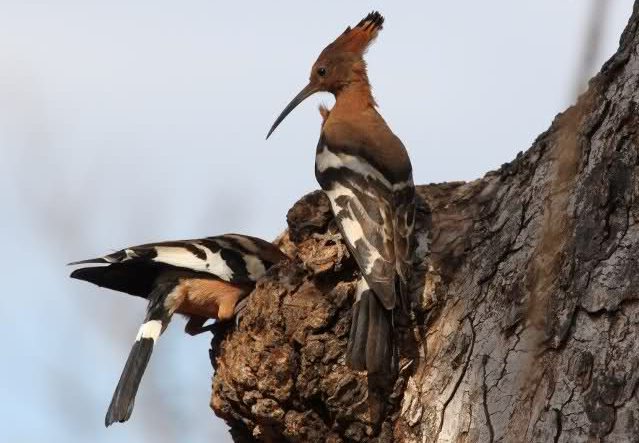 © nan
© nan
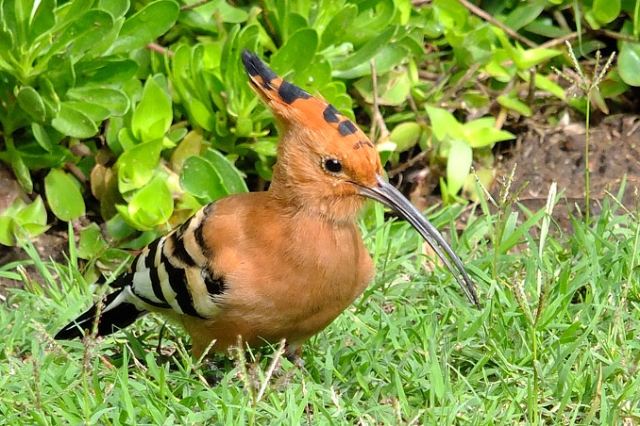 © PJL
© PJL
Garden in Port Elizabeth, Eastern Cape
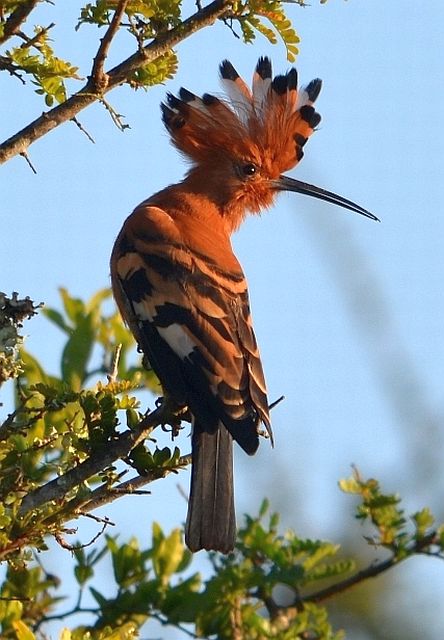 © Mel
© Mel
Links:
Species text Sabap1
Sabap2: http://sabap2.adu.org.za/spp_summary.ph ... §ion=3
Ian Sinclair,P. A. R. Hockey. The Larger Illustrated Guide to Birds of Southern Africa
 © Flutterby
© Flutterby © Dewi
© DewiKruger National Park, Skukuza
 © nan
© nan © nan
© nan © PJL
© PJLGarden in Port Elizabeth, Eastern Cape
 © Mel
© MelLinks:
Species text Sabap1
Sabap2: http://sabap2.adu.org.za/spp_summary.ph ... §ion=3
Ian Sinclair,P. A. R. Hockey. The Larger Illustrated Guide to Birds of Southern Africa
Family Phoeniculidae (Wood Hoopoes)
The Wood hoopoes and scimitarbills are a small African family, Phoeniculidae, of near passerine birds. They live south of the Sahara Desert and are not migratory. While the family is now restricted to sub-Saharan Africa, fossil evidence shows that the family once had a larger distribution. The wood hoopoes are related to the kingfishers, the rollers, and the Hoopoe. A close relationship between the Hoopoe and the woodhoopoes is also supported by the shared and unique nature of their stapes. They most resemble the true Hoopoe with their long down-curved bills and short rounded wings.
The wood hoopoes are a morphologically distinct group, unlikely to be mistaken for any other. These species are medium-sized (23 to 46 cm long, much of which is the tail). They have metallic plumage, often blue, green or purple, and lack a crest. The sexes are similar in all but two species, the Forest Wood Hoopoe and Common Scimitarbill. Their bills are either red or black, although young red-billed species also have black bills and bill colour is correlated with age. The legs are scarlet or black; the legs are short, with thick tarsi. When climbing up the trunks of trees they do so in the manner of a woodpecker, and when feeding on the ground they hop instead of walking like the true Hoopoe. Their tails are long and strongly graduated (the central feathers are the longest), and marked conspicuously with white, as are their wings.
These are birds of open woodland, savannah, or thornbrush, and are mainly arboreal. They require large trees both for feeding on as well as to provide hollows for nesting and nocturnal roosting. Two species are found exclusively in rainforest, the Forest Wood Hoopoe and the White-headed Wood Hoopoe, all the other species are found in more open woodland and bush.
They feed on arthropods, especially insects, which they find by probing with their bills in rotten wood and in crevices in bark. They nest in unlined tree holes, laying two to four eggs, which are blue, grey, or olive, unmarked in most species.
The wood hoopoes are a morphologically distinct group, unlikely to be mistaken for any other. These species are medium-sized (23 to 46 cm long, much of which is the tail). They have metallic plumage, often blue, green or purple, and lack a crest. The sexes are similar in all but two species, the Forest Wood Hoopoe and Common Scimitarbill. Their bills are either red or black, although young red-billed species also have black bills and bill colour is correlated with age. The legs are scarlet or black; the legs are short, with thick tarsi. When climbing up the trunks of trees they do so in the manner of a woodpecker, and when feeding on the ground they hop instead of walking like the true Hoopoe. Their tails are long and strongly graduated (the central feathers are the longest), and marked conspicuously with white, as are their wings.
These are birds of open woodland, savannah, or thornbrush, and are mainly arboreal. They require large trees both for feeding on as well as to provide hollows for nesting and nocturnal roosting. Two species are found exclusively in rainforest, the Forest Wood Hoopoe and the White-headed Wood Hoopoe, all the other species are found in more open woodland and bush.
They feed on arthropods, especially insects, which they find by probing with their bills in rotten wood and in crevices in bark. They nest in unlined tree holes, laying two to four eggs, which are blue, grey, or olive, unmarked in most species.
Family Phoeniculidae (Wood Hoopoes) Index
Family Phoeniculidae (Wood Hoopoes)
Phoeniculus purpureus Green Wood-Hoopoe 452
Phoeniculus damarensis Violet Wood-Hoopoe 453
Rhinopomastus aterrimus Black Scimitarbill
Rhinopomastus cyanomelas Common Scimitarbill 454
Phoeniculus purpureus Green Wood-Hoopoe 452
Phoeniculus damarensis Violet Wood-Hoopoe 453
Rhinopomastus aterrimus Black Scimitarbill
Rhinopomastus cyanomelas Common Scimitarbill 454


